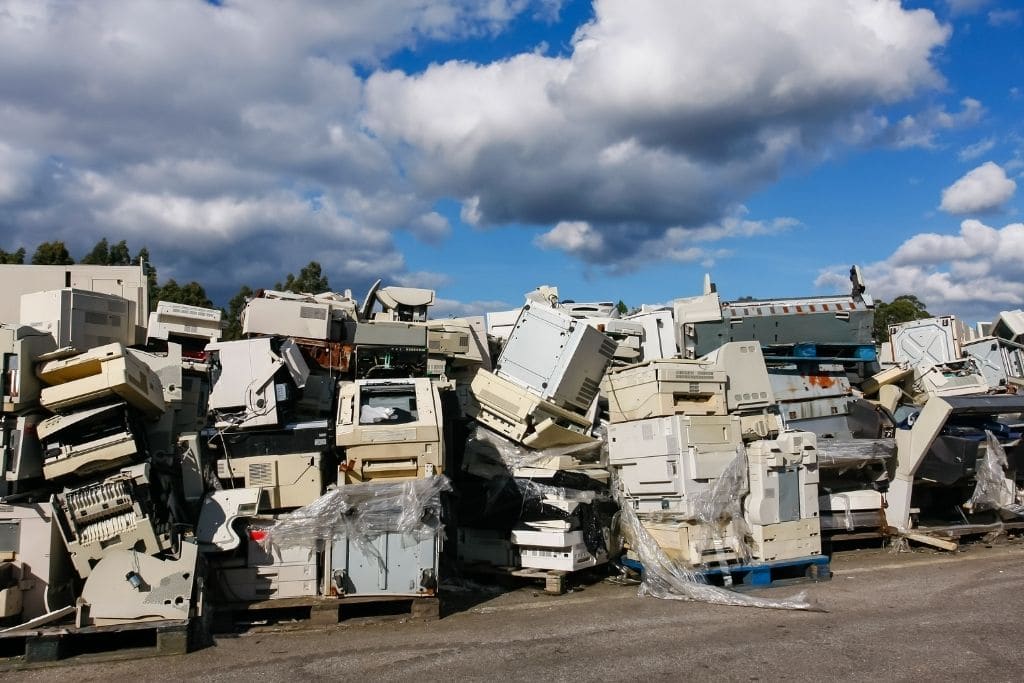Unchecked electronic waste disposal has a cascade effect on human health, the natural environment and even the Earth’s natural rhythms. Tackling e waste pollution is an essential and pressing human and environmental issue.
—
It’s no secret that humans generate all manners of waste. Residential and commercial waste exist, including municipal, animal and industrial, radioactive or hazardous waste, and more. It must then be managed through reusing, recycling, storage, treatment or disposal. Most of it is sent to one of the many landfills scattered throughout the country.
One type of waste that people may not be aware of is electronic waste, more commonly known as e-waste. E-waste is becoming a more significant issue, especially as we become more dependent on technology. Below, we will learn more about e-waste, how big an issue e-waste is, and what type of impact a growing amount of e waste pollution has on the environment.
What Is E Waste?
Electronic waste, or e-waste, consists of devices that owners no longer want, have stopped working or are obsolete compared to new emerging technologies. Common types of e-waste are old DVD players, remote controls, laptops, desktop computers, cellphones, hard drives and televisions.
The average American household has 11 connected devices, but what happens when those devices stop working or these households upgrade to new devices? The answer is complicated.
Some older devices are in good condition, whereas others are way past their prime. Others end up collecting dust in the junk drawer, never to be seen again. Many people are unsure about how they can properly dispose of e-waste, and some will simply throw out old devices into their household trash when they can be recycled or repaired. These end up in already packed landfills or are otherwise discarded improperly in nearby open spaces, damaging and potentially degrading natural habitats.
The Growing Amount of E Waste Pollution
The proper disposal of electronics is a heated topic in the minds of those looking to live more sustainably and reduce their carbon footprint. As more devices come out each year, it only adds to the amount of e-waste generated. Consider how Apple, Huawei, Samsung, Google and other companies release several new phone models annually. Older models then become obsolete and must be disposed of properly.
Statista reports that the amount of e-waste generated worldwide was around 54 million metric tons in 2019. Due to increased spending power and the wide availability of electronics, e-waste is becoming the fastest-growing waste stream worldwide. It’s estimated that generation will increase by 30% by 2030.
These figures make sense, considering how common it is for people to throw away small electronic devices along with their other trash. However, most are not aware of opportunities to recycle electronics, what environmental impact they’re making by throwing away e-waste or how much cash they can earn by selling it.
How E Waste Harms the Environment and Our Health
Why is e-waste becoming a more prevalent issue worldwide? Electronic waste poses unique ecological concerns. Most e-waste contains hazardous chemicals, and the manufacturing processes may also harm the environment.
When e-waste ends up in a landfill, the surrounding soil can become contaminated with toxic substances such as mercury, cadmium, beryllium and lead. These chemicals enter the soil, waterways and air, leading to polluted environments and negatively impacting human and marine life.
Consider people who use natural wells or the animals who rely on bodies of water. They could be exposed to toxic chemicals that can impact their health.
It’s also important to note that when high volumes of e-waste enter landfills, device manufacturers must mine more materials to build new devices. Phones and other electronics contain small amounts of valuable metals like gold, silver and palladium, among other critical components. These materials are becoming harder to mine, especially with the increased demand for more electronic devices.
You might also like: Global E-Waste Will Weigh More Than the Great Wall of China
How E Waste Contributes to Air Pollution
One journal from Environmental Research Letters reported that researchers took air samples from a large e-waste disposal site in China and found that the products in these landfills harmed human lung cells.
According to the World Health Organization (WHO), these are some adverse health effects caused by exposure to e-waste:
- Negative birth outcomes for expecting mothers, such as stillbirth or premature birth
- Increased rates of ADHD in young children
- Changes in lung function
- DNA damage
- Respiratory issues
- Impaired thyroid function
- Increased risk of chronic diseases like cancer and cardiovascular disease
Additionally, the WHO reports that appropriate collection and recycling of e-waste can help protect the environment and human health.
Global E-waste Statistics Partnership (GESP) found that 17.4% of e-waste that was collected appropriately prevented as much as 15 million tons of carbon dioxide from being emitted into the atmosphere. High levels of carbon dioxide entering the environment and therefore contributing to global warming make it clear that e-waste is a much larger issue than some believe it to be. It may seem easy to toss away old electronics in the trash, but doing so negatively affects the environment and can harm human health.
Recycling Electronics to Benefit Humans and the Environment
More state and federal action is needed to reduce the negative impact e-waste has on humans and the environment. So far, around 25 US states and the District of Columbia have passed legislation to establish an e-waste recycling programme. Additionally, several manufacturers offer some type of electronic return initiative, with some hosting or sponsoring recycling events for consumers.
Many manufacturers have adopted more sustainable business practices to prevent outdated devices from entering landfills. However, this can be challenging, considering how often users want to upgrade to the latest technology due to new features and designs.
Republicans and Democrats are pursuing laws that would make it easier for consumers to repair their devices, from vehicles to refrigerators to smartphones. This movement is being coined as the Right to Repair movement. Manufacturers often make it difficult for consumers to fix a wide range of products by limiting the availability of parts or limiting who can perform repairs.
The goal of the movement is to prohibit manufacturers from taking these measures. This can directly reduce the amount of e-waste entering landfills in the first place. Consumers would then be able to repair devices themselves, save money and avoid tossing obsolete products in the trash.
E-waste is a growing problem worldwide, and more emphasis should be put on the importance of recycling electronics. The benefits of recycling far outweigh the drawbacks. Governments, consumers and manufacturers need to find viable solutions to this prevalent issue. Whether it’s contaminated soil entering waterways or toxic chemicals released into the atmosphere, more work needs to be done to mitigate the negative effects e-waste causes.
You might also like: Apple Joins the Right to Repair Movement


















